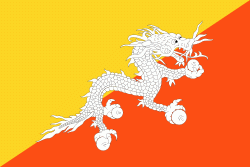Bhutanese ngultrum
Nu
The ngultrum (དངུལ་ཀྲམ, symbol: Nu., code: BTN) is the currency of the Kingdom of Bhutan. It can be literally translated as 'silver' for ngul and 'coin' for trum. It is subdivided into 100 chhertum (ཕྱེད་ཏམ, spelled as chetrums on coins until 1979). The Royal Monetary Authority of Bhutan, the central bank of Bhutan is the minting authority of the ngultrum banknotes and coins. The ngultrum is currently pegged to the Indian rupee at parity.Until 1789, the coins of the Cooch Behar mint circulated in Bhutan. Following this, Bhutan began issuing its own coins known as chetrum, mostly silver 1⁄2 rupees. Hammered silver and copper coins were the only types issued until 1929, when modern style silver 1⁄2 rupee coins were introduced, followed by bronze 1 paisa in 1931 (dated 1928). Nickel 1⁄2 rupee coins were introduced in 1950. While the Cooch Behar mint coins circulated alongside Bhutan's own coins, decimalization was introduced in 1957, when Bhutan's first issue of coins denominated in naya paisa. The 1966 issues were 25 naya paisa, 50 naya paisa and 1 rupee coins, struck in cupro-nickel.
While the Bhutanese government developed its economy in the early 1960s, monetization in 1968 led to the establishment of the Bank of Bhutan. As monetary reforms took place in 1974, the Ngultrum was officially introduced as 100 Chhetrum equal to 1 Ngultrum. The Ngultrum retained the peg to the Indian rupee at par, which the Bhutanese coins had maintained.
The term derives from the Dzongkha ngul, "silver" and trum, a Hindi loanword meaning "money."
The Ministry of Finance issued its first banknotes in 1974 in denominations of Nu.1, Nu.5, Nu.10 and Nu.100. This was followed by the establishment of the Royal Monetary Authority of Bhutan as the central bank of Bhutan in 1982, which took over the authority to issue banknotes in 1983, replacing the authority of the Ministry of Finance.
Country
-
Bhutan
Bhutan (འབྲུག་ཡུལ་ ), officially the Kingdom of Bhutan (འབྲུག་རྒྱལ་ཁབ་), is a landlocked country in South Asia. It is situated in the Eastern Himalayas, between China in the north and India in the south. A mountainous country, Bhutan is known locally as "Druk Yul" or "Land of the Thunder Dragon", a name reflecting the cultural heritage of the country. The exonym Bhutan likely derives from the Prakrit hybrid word Bhŏṭṭaṃta, a name referring to its geographical proximity to Tibet. Nepal and Bangladesh are located near Bhutan but do not share a border with it. The country has a population of over 727,145 and territory of 38394 km2 and ranks 133rd in terms of land area and 160th in population. Bhutan is a constitutional monarchy with a king (Druk Gyalpo) as the head of state and a prime minister as the head of government. Vajrayana Buddhism is the state religion and the Je Khenpo is the head of state religion.
The subalpine Himalayan mountains in the north rise from the country's lush subtropical plains in the south. In the Bhutanese Himalayas, there are peaks higher than 7000 m above sea level. Gangkhar Puensum is Bhutan's highest peak and is the highest unclimbed mountain in the world. The wildlife of Bhutan is notable for its diversity, including the Himalayan takin and golden langur. The capital and largest city is Thimphu, holding close to 1/7th of the population.
